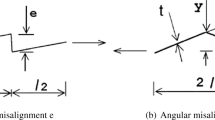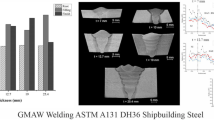Abstract
Weld distortion is particularly problematic for large thin structures that are used in the assembly of ships. The drive toward lighter ships and thinner plate is restricted by the significant increase in distortion as the plate thickness decreases. The influence of pre-existing deformation in the plates to be joined on the resultant distortion in gas metal arc welded structure has been studied. DH-36 steel plate surface profiles were measured before and after the butt welding of two plates 1000 × 500 × 4 mm in size. Three dimensional finite element models that incorporate the initial plate profile have been created to simulate the welding process and to examine the relationship between the final welded plate profiles and the initial deformation present in the plates. Both symmetric and asymmetric models were considered. A significant variation in the unwelded base plates’ initial distortion was observed. Generally, it has been found that if an out-of-plane deformation exists in a plate prior to welding, the level of distortion further increases in the same direction following welding. The final distortions are strongly related to the initial plate profiles. The residual stress distributions in the plates are also to some extent affected by the level of distortion initially present.














Similar content being viewed by others
References
M.J. Bibby, J.A. Goldak, and G.Y. Shing, G.Y. A Model for Predicting the Fusion and Heat-Affected Zone Sizes of Deep Penetration Welds, Can. Metall. Q., 1985, 24, p 101–105
L.E. Lindgren and L. Karlsson, Deformations and Stresses in Welding of Shell Structures, Int. J. Numer. Methods Eng., 1988, 25, p 635–655
S. Oddy, J.A. Goldak, and J.M.J. McDill, Transformation Plasticity and Residual Stresses in Single-Pass Repair Welds, J. Press. Vessel. Technol., 1992, 114, p 33
D. Dye, O. Hunziker, S.M. Roberts, and R.C. Reed, Modeling of the Mechanical Effects Induced by the Tungsten Inert-Gas Welding of the IN718 Superalloy, Metall. Trans. A, 2001, 32, p 1713–1725
Z. Sadovský, A.P. Teixeira, and C. Guedes, Soares, Degradation of the Compression Strength of Square Plates due to Initial Deflection, J. Constr. Steel Res., 2006, 62, p 369–377
W. Cui and A.E. Mansour, Effects of Welding Distortions and Residual Stresses on the Ultimate Strength of Long Rectangular Plates under Uniaxial Compression, Mar. Struct., 1998, 11, p 251–269
L. Gardner and D.A. Nethercot, Numerical Modeling of Stainless Steel Structural Components—A Consistent Approach, J. Struct. Div., Am. Soc. Civ. Eng., 2004, 130, p 1586–1601
F. Mateus and J.A. Witz, A Parametric Study of the Post-buckling Behaviour of Steel Plates, Eng. Struct., 2001, 23, p 172–185
Y.P. Yang and F.W. Brust, Weld Modeling of Thin Structures with VFT Software, ASME Pressure Vessels Piping Conf., Proc., Jul 25-29, 2004 (San Diego), ASME, 2004, San Diego, p 99–107
P. Mollicone, D. Camilleri, and T. Gray, Procedural Influences on Non-linear Distortions in Welded Thin-Plate Fabrication, Thin Walled Struct., 2008, 46, p 1021–1034
M. Tsunori, C.M. Davies, D. Dye, and K.M. Nikbin, Numerical Modelling of Residual Stress and Distortion in Thin Welded Steel Plates, ASME Pressure Vessels Piping Conf., Proc., Jun 27-31, 2008 (IL), ASME, p 299–307
M.P. Lightfoot, N.A. McPherson, K. Woods, and G.J. Bruce, Artificial Neural Networks as an Aid to Steel Plate Distortion Reduction, J. Mater. Process. Technol., 2006, 172, p 238–242
E. Røed, Certified Material Tests Report. Norsk Sveiseteknikk AS, Norway, 2006
V. Lexhas, Inspection Certificate. DUFERCO CLABECQ SA, Belgium, p. Certificate Number ANT : 0500001/0500474, 2006
M.M. Goldan, As-Built Product Modeling and Reverse Engineering in Shipbuilding Through Combined Digital Photogrammetry and CAD/CAM Technology, J. Ship. Prod., 2003, 19, p 98–104
C.M. Davies, R.C. Wimpory, M. Béreš, M.P Lightfoot, D. Dye, E. Oliver, N.P. O’Dowd, and J.G. Bruce, The Effect of Residual Stress and Microstructure on Distortion In Thin Welded Steel Plates, Jul 22-26, 2007 (Texas), ASME Pressure Vessels Piping Conf., Proc., 2007 (TX), p 851–858
T.D. Huang, P. Dong, L.A. DeCan, and D.D. Harwig, Residual Stresses and Distortions in Lightweight Ship Panel Structures, Technol. Rev. J., 2003, 11(2003), p 1–26
N.A. McPherson, Thin Plate Distortion Reduction—A Management or Technology Issue?, Weld. Cut., 2006, 5, p 277–282
ABAQUS, Analysis User’s Manual v 6.6. ABAQUS, Inc., 2006
H.J. Stone, S.M. Roberts, and R.C. Reed, A Process Model for the Distortion Induced by the Electron-Beam Welding of a Nickel-Based Superalloy, Metall. Trans. A, 2000, 31, p 2261–2273
S.A. Tsirkas, P. Papanikos, and T. Kermanidis, Numerical Simulation of the Laser Welding Process in Butt-Joint Specimens, J. Mater. Process. Technol., 2003, 134, p 59–69
H. Murkawa, M. Béreš, C.M. Davies, S. Rashed, A. Vega, M. Tsunori, K.M. Nikbin, and D. Dye, Effect of Low Transformation Temperature Weld Filler Metal on Welding Residual Stress, Sci. Technol. Weld. Join., 2010, 15, p 393–399
J. Goldak, A. Chakravarti, and M. Bibby, New Finite Element Model for Welding Heat Sources, Metall. Trans. B, 1984, 15(2), p 299–305
L.E. Lindgren, Finite Element Modeling and Simulation of Welding. Part 2: Improved Material Modeling, J. Therm. Stresses, 2001, 24(3), p 195–231
N.A. McPherson, Personnal Communication. BVT Surface Fleet Ltd., 2008
L.E. Lindgren, Finite Element Modeling and Simulation of Welding Part 1: Increased Complexity, J. Therm. Stresses, 2001, 24(2), p 141–192
M.C. Smith and A.C. Smith, NeT Bead-on-Plate Round Robin: Comparison of Residual Stress Predictions and Measurements, Int. J. Press. Vessel. Pip., 2009, 86, p 79–109
H. Murakawa, M. Béreš, A. Vega, S. Rashed, C.M. Davies, D. Dye, and K.M. Nikbin, Effect of Phase Transformation onset Temperature on Residual stress in Welded Thin Steel Plates, Trans. JWRI, 2008, 37, p 75–80
R.V. Preston, H.R. Shercliff, P.J. Withers, and S. Smith, Physically-Based Constitutive Modelling of Residual Stress Development in Welding of Aluminium Alloy 2024, Acta Mater., 2004, 52, p 4973–4983
C.M. Davies, M. Béreš, D. Hughes, D. Dye, and K.M. Nikbin, The Influence of Geometric and Welding Parameters on Residual Stress in Thin Welded Steel Structures, Jul 26-30, 2009 (Prague), ASME Pressure Vessels Piping Conf., Proc., 2009 (Prague) p 327–334
X. Shan, C.M. Davies, T. Wangsdan, N.P. O’Dowd, and K.M. Nikbin, Thermo-Mechanical Modelling of a Single-Bead-on-Plate Weld using the Finite Element Method, Int. J. Press. Vessel. Pip., 2009, 86, p 110–121
P. Mollicone, D. Camilleri, T. Gray, and T. Comlekci, Simple Thermo-Elastic-Plastic Models for Welding Distortion Simulation, J. Mater. Process. Technol., 2006, 176, p 77–86
M. Abid and M. Siddique, Numerical Simulation to Study the Effect of Tack Welds and Root Gap on Welding Deformations and Residual Stresses of a Pipe-Flange Joint, Int. J. Press. Vessel. Pip., 2005, 82, p 860–871
Acknowledgments
The authors would like to acknowledge Dr. Martyn Lightfoot of Newcastle University for the provision of the experimental distortion data and Dr. Norrie McPherson of BAE Systems, Govan, Scotland, UK for provision of welding facilities and materials. Funding was supplied via EPSRC Grants EP/D060729/1, GR/T26344/01 and EP/H004882/1.
Author information
Authors and Affiliations
Corresponding author
Rights and permissions
About this article
Cite this article
Davies, C.M., Ahn, J., Tsunori, M. et al. The Influence of Pre-existing Deformation on GMA Welding Distortion in Thin Steel Plates. J. of Materi Eng and Perform 24, 261–273 (2015). https://doi.org/10.1007/s11665-014-1313-0
Received:
Revised:
Published:
Issue Date:
DOI: https://doi.org/10.1007/s11665-014-1313-0




